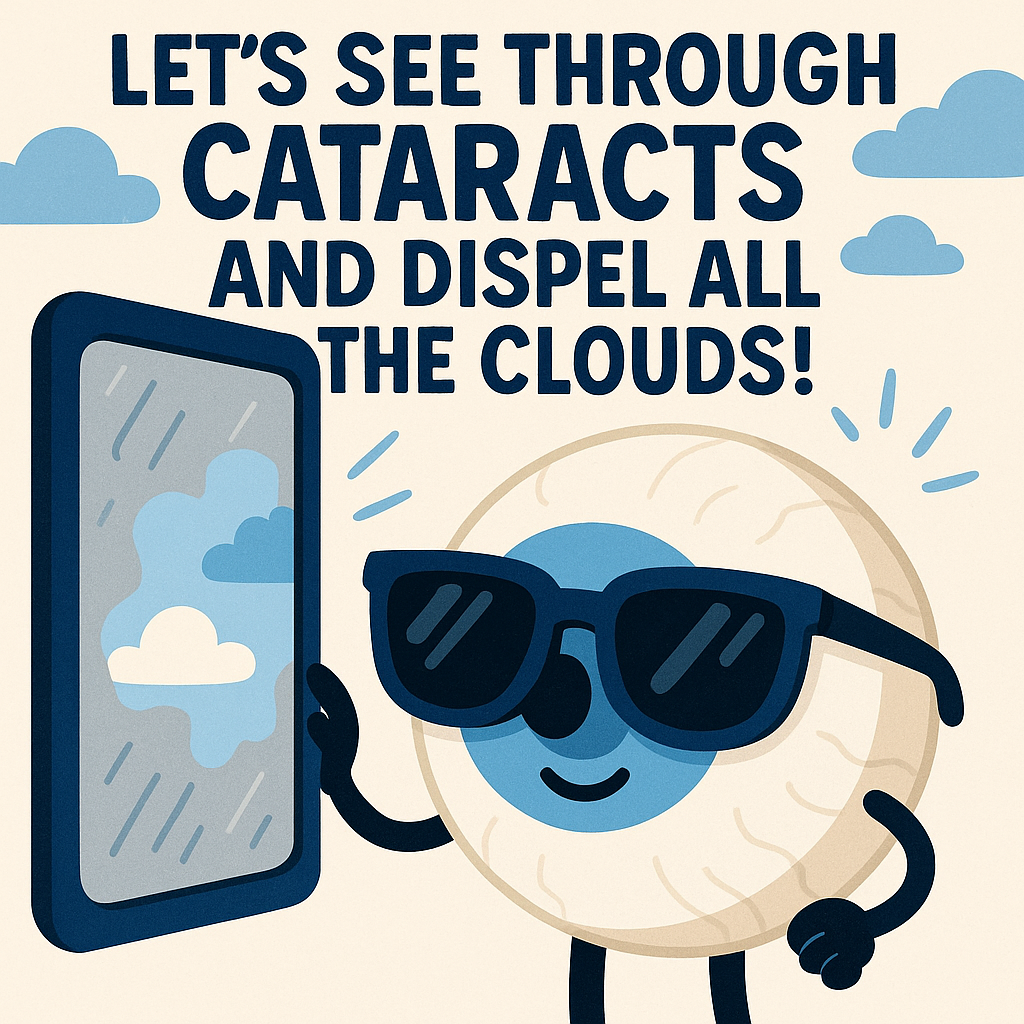
Let's See Through Cataracts and Dispel All The Clouds!
May 28, 2025
So… your vision’s blurry, headlights look like supernovas, and your friend just waved at a stranger because they couldn’t tell it wasn’t you? Welcome to cataract country—population: too many! 👁️
😶 What’s a Cataract? ☁️➡️🌞
A cataract is when the lens of your eye decides to go mood lighting mode, clouding over like a foggy car windshield. Reading, driving at night, or checking if your date is smiling—or even the same person—gets trickier.
At first, stronger glasses and brighter lights might help. But eventually, you may need to trade the cloud for clarity via cataract surgery—a safe and widely done procedure. ✨
☁️ Common Symptoms
-
Blurry or dim vision
-
Difficulty seeing at night (no, sleep still doesn’t count)
-
Light sensitivity and glare 👀💥
-
Need for stadium-level lighting to read 📚
-
Halos around lights (they’re not angelic signs) 👼💡
-
Frequent lens prescription changes
-
Colors fading or yellowing 🎨➡️☁️
-
Double vision in one eye 👁️👁️ (when two’s a crowd)
It often starts small, but as the fog rolls in, it spreads across your vision like a bad weather forecast.
🧪 What Causes Cataracts?
Aging and injury are the usual suspects. As you age, lens proteins break down and clump together. This creates the cloud party that nobody RSVP’d for.
Other possible culprits:
-
Genetics 👩👧
-
Diabetes 🍩
-
Long-term steroid use 💊
-
Eye injuries 🥊
-
Surgeries 🏥
-
Smoking 🚬
-
Sunlight 🌞 (wear your shades!)
🔍 For the National Eye Institute's take on cataracts, see here.
🧬 Types of Cataracts
🧨 Nuclear Cataracts (Center of the Lens)
They blur faraway objects, then shift to full blur mode. Colors may yellow, but reading might weirdly improve before things go full sepia filter.
🍕 Cortical Cataracts (Edges of the Lens)
White wedge-shaped streaks sneak in from the sidelines and eventually ruin the whole show. Think pizza slices of blur.
💥 Posterior Subcapsular Cataracts (Back of the Lens)
They hit where it hurts—right in your reading zone. Often lead to glare explosions and halo shows at night.
👶 Congenital Cataracts (From Birth or Early Childhood)
May be inherited or linked to in-womb infections like rubella. Sometimes harmless, sometimes removed early.
⚠️ Risk Factors
-
Age (sorry, birthday cake not included)
-
Diabetes
-
UV exposure (sunlight = 👎)
-
Smoking and alcohol
-
Obesity
-
Eye trauma or surgery
-
Family history
Don't Sleep on These Rules—Or Even Your Sleep Will Take a Siesta!
🩺 Cataract Surgery: When Foggy Lenses Need Eviction
So what happens when it’s finally time to tell your cloudy lens to hit the road? Enter: cataract surgery — the optometric equivalent of clearing browser history.
👨⚕️ Cataract surgery is a procedure where your eye’s natural lens is removed and replaced with a shiny new artificial one (sort of like Lasik meets IKEA).
It’s done by an ophthalmologist, usually on an outpatient basis. You come in, they swap your lens, and boom—you’re free to go. No overnight stay, just sharper vision and maybe a cool pirate patch for a few hours.
💡 Why It’s Done:
-
To treat cataracts that are messing with your daily life
-
To help doctors see the back of your eye if you have other issues like macular degeneration
⏳ No rush though. You can wait until the fog really starts to cramp your lifestyle.
🚨 Risks (Spoiler: Rare, But Worth Mentioning)
-
Swelling, infection, or bleeding (meh)
-
Droopy eyelid (sleepy but chic?)
-
Dislocated lens
-
Retinal detachment (dramatic)
-
Glaucoma or secondary cataracts
-
Vision loss (again, rare!)
Risks increase if you have other eye problems, so be sure to consult with your eye doc.
👀 After the Procedure:
-
Vision starts improving within days
-
Colors may look extra bright (goodbye, yellow tint!)
-
Expect a few follow-ups: Day 1, Week 1, and Month 1
-
Glasses might still be needed for reading or detail work
💸 Costs vary ($3,500–$7,000 per eye), but insurance and Medicare usually help cover it.
🛡️ Prevention (Sort Of…)
There’s no surefire cure, but lifestyle choices help.
👁️ Get regular eye exams
🚭 Don’t smoke
🍎 Eat your fruits & veggies
🕶️ Rock UV-blocking sunglasses
🍷 Limit alcohol (yes, even wine with dinner)
🩺 Manage health issues like diabetes
👨⚕️ Final Diagnosis: Keep Your Vision Sharp
Cataracts are part of the human aging saga. But with proactive care, snazzy sunglasses, and a surgeon when needed, the future’s still bright—literally.
💬 Not sure if your vision’s cloudy or just your outlook? Make an appointment. If you see halos but not heaven, it’s probably just cataracts. 😎
📛 Disclaimer:
We’re not doctors, we just play ophthalmologist with emojis. If you experience sudden vision loss, pain, or hallucinate an optometrist in your dreams—call a real medical professional.
🧭 Want More Like This?
👉 Visit our Health & Wellness Hub
👉 Or clear your mind with our Humor + Travel Section
Other articles:
Quick links
Search
Privacy Policy
Refund Policy
Shipping Policy
Terms of Service
Contact us
About us
FUNanc!al distills the fun in finance and the finance in fun, makes news personal, and helps all reach happiness.

Got a thought? A tip? A tale? We’re all ears — drop it below.: